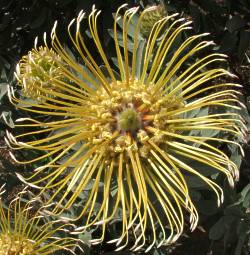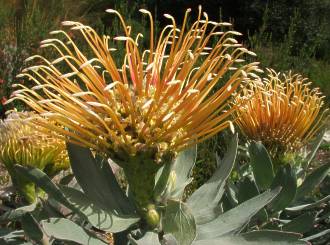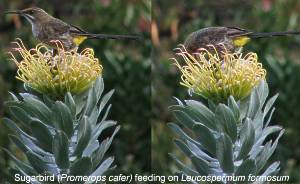Leucospermum formosum
Leucospermum formosum (Andrews) Sweet
Family: Proteaceae
Common names: silver-leaf wheel-pincushion
Introduction
Leucospermum formosum has spectacular bright yellow spring flowers that look like a Catherine wheel firework frozen in mid spin.

Description
Description
Leucospermum formosum is a large, upright shrub 2-3 m tall. Leaves are lance-shaped to egg-shaped, with 3 glandular teeth at the tip and have no stalk. The leaf surface is covered with a dense mat of fine grey hairs that is softly velvety to the touch and does not rub off. The flower heads are large and showy, pale golden yellow and are produced during spring (Sept.-Oct.). The flower head in bud is shaped like a top.

When the flowers open, the styles elongate rapidly, up to 70-80 mm, curve away from the centre, and twist in a clockwise direction near the tip, giving the flower head the appearance of a spinning wheel. When fully open, the flower heads are up to 150 mm in diameter. The styles are pale yellow, and the tips are white with pink tips. As the flower head ages, the styles move into an upward pointing position, and change colour, getting a pinkish blush that deepens to bronze. During the flowering period, each style will have moved through 90 degrees. Seeds are released about two months after flowering. They are small nuts covered by a soft, fleshy, white skin.
Leucospermum formosum is closely related and very similar to L. catherinae, the Catherine-wheel Pincushion. Their distribution ranges don't overlap, and so they should not be confused in the field, but in the garden they can be distinguished from each other by their leaves: The leaves of L. formosum have no stalk and are covered by a mat of grey hairs that does not rub off; whereas the leaves of L. catherinae are green and hairless, and have a distinct stalk.
Conservation Status
Status
Endangered. Leucospermum formosum faces a very high risk of extinction in the wild in the near future. It is known from only a few, scattered populations and has lost more than 50% of its population. Its geographic range is small and fragmented and is continuing to decline. It is threatened by urbanisation, timber plantations and agriculture. It is also at risk from too-frequent fires, i.e. where a population is not given sufficient time to re-establish a seed bank between fires.
Distribution and habitat
Distribution description
Leucospermum formosum occurs in the Riversonderend Mountains, the Langeberg and the Outeniqua Mountains where it grows on the cool, southern slopes on moist, peaty soils, 200-1000 m above sea level. Rainfall in this area is evenly distributed throughout the year.
Derivation of name and historical aspects
History
The genus Leucospermum is named from the Greek leukos meaning white, and sperma seed, referring to the white or light-coloured seeds of many species. The species epithet formosum means beautiful, finely formed, handsome, having a fine appearance (Latin).
The genus Leucospermum is a member of the protea family. It consists of 48 species that occur in southern Africa as far north as Zimbabwe, with the majority occurring in the winter rainfall region of the Western Cape.
Leucospermum formosum was first described in 1798 by the English botanist and botanical artist Henry Charles Andrews as Protea formosa. The description was accompanied by a colour plate, which he drew from a plant grown in the nursery of Leigh and Kennedy in 1796, from seed collected by Francis Masson.
Ecology
Ecology
The brightly coloured, unscented flower heads are pollinated by nectar-feeding Sugarbirds and Sunbirds. Judging by the length of the style, the Sugarbird is probably the main pollinator. The birds perch on the flower head and probe into the flower head in search of nectar, and in so doing their heads and necks come into contact with the pollen presenters and stigmas at the tips of the styles. The flower heads are also visited by bees and beetles but they don't come into contact with the pollen presenters and thus do not pollinate.

The fleshy coating on the seeds is an elaiosome that attracts ants. The seeds fall from the flower heads when ripe, and ants carry them away to their nests where they consume the elaiosome, but do not harm the seeds. In this way the seeds are dispersed and stored safely underground. This is known as myrmecochory. After a fire, the adult plants are killed but the seeds in the ant nests germinate to regenerate the population.
Uses
Use
Leucospermum formosum is a very attractive garden shrub, both for its grey foliage and large, showy, bright yellow spring flowers. The flowers make long-lasting cutflowers, but it is not one of the species that is widely cultivated, and is therefore not often seen for sale as a cutflower. Leucospermum 'Spider', a hybrid between L. tottum and L. formosum, also makes an excellent garden shrub and has attractive, long-lasting cutflowers.

Growing Leucospermum formosum
Grow
Leucospermum formosum requires a sunny position, with free air circulation, in well-drained, acidic soil and moderate water all year round. Do not use rich manure or strong fertilisers, apply generous amounts of well-rotted compost in autumn and spring. If required, feed with low doses of regular fertiliser, or use a slow-release fertiliser.
Leucospermum formosum is a lovely garden shrub, ideal for fynbos gardens. It is also suitable for summerrainfall, non-fynbos gardens, provided the soil is well-drained and the site is not humid. It is relatively fast growing, producing flowers from its third season from seed.
Leucospermum formosum can be propagated by seed or cuttings. Sow seed in late summer to autumn (March-May). Use a well-drained medium, e.g. one or two parts coarse sand, one part leaf mould and one part loam. Cover the seeds with coarse, clean sand or milled bark and keep warm and moist. Seeds need alternating cold night and warm day temperatures of 4-10°C and 15-20°C to initiate germination. Such temperatures are typical of autumn in the Western Cape and indicate the start of the rainy season. Germination can be improved if the seeds are soaked in a 1% solution of hydrogen peroxide for 24 hours. This oxygenates the seed and softens and loosens the seed coat, which should be rubbed off.
Treatment with Instant Smoke Plus Seed Primer will also enhance germination. Watering the seed tray with a fungicide will prevent fungal disease. Germination takes 1-2 months and the young seedlings are ready to be potted up as soon as they have developed their first set of true leaves. Seedlings are best planted into the garden when at least one year old, and first flowers can be expected from their third year.
Take semi-hardwood tip cuttings or heel cuttings from the current season's growth in late summer-autumn (March-May). Treat with rooting hormone and place in a well-drained medium and place under mist with bottom heat of 24°C. Good air circulation is required to prevent fungal infection.
References
- http://en.wikipedia.org/wiki/Henry_Charles_Andrews
- Leistner, O.A. (ed.). 2000. Seed plants of southern Africa : families and genera. Strelitzia 10. National Botanical Institute, Pretoria.
- National Red Data List of South African Plants 03-02-2009, available at www.sanbi.org or redlist@sanbi.org
- Plants of southern Africa : an online checklist. http://posa.sanbi.org
- Protea Atlas Project. http://protea.worldonline.co.za
- Rebelo, Tony. 2001. Proteas, A field guide to the proteas of Southern Africa, 2nd edn. Fernwood Press, Cape Town.
- Rebelo, Tony et al. Manuscript, version Dec. 2006. African Proteaceae Red Data List to be submitted to Strelitzia.
- Rourke, J.P. 1972. Taxonomic studies on Leucospermum R.Br. Journal of South African Botany, Supplementary Volume 8
Credits
Alice Notten
Kirstenbosch National Botanical Garden
December 2009
Plant Attributes:
Plant Type: Shrub
SA Distribution: Western Cape
Soil type: Sandy
Flowering season: Spring
PH: Acid
Flower colour: Pink, Yellow
Aspect: Full Sun
Gardening skill: Average
Special Features:
Horticultural zones










Rate this article
Article well written and informative
Rate this plant
Is this an interesting plant?
Login to add your Comment
Back to topNot registered yet? Click here to register.